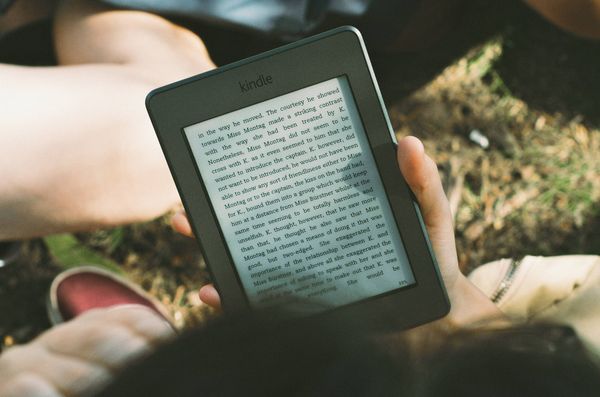Sam Thomas Davies • • 6 min read
The 10% Rule: How to Read More Than 42+ Books a Year

In my whole life, I have known no wise people (over a broad subject area) who didn’t read all the time – none, zero. You’d be amazed at how much Warren [Buffett] reads – and how much I read. My children laugh at me. They think I’m a book with a couple of legs sticking out
– Charles T. Munger.
When asked his secret to success, Warren Buffett – the most successful investor of all time – held up a stack of papers and replied: “[You] read 500 pages like this every day. That’s how knowledge builds up, like compound interest”. [1]
500 pages a day? That’s a lot to ask for, right? As valuable as that knowledge would be, most of us don’t have the time nor the patience to perform a daily feat like that.
However, if you’re an artist, an entrepreneur, or any kind of a creative for that matter, you’ll understand how important reading is as a daily habit.
Reading is learning and if you’re not learning, you’re not improving in your craft.
Stephen King once commented:
“If you don’t have time to read, you don’t have the time (or the tools) to write. Simple as that”. [2]
Fortunately, it is possible to read more books, deepen your knowledge and improve your craft — without it feeling like an effort or drain on your precious resources and time.
With Amazon Kindles, Nooks, smart phone apps and tablets available to us, books have never been more accessible – nor easier to read. No longer do you have to lug a heavy hard/paperback book around with you or wait for a book order to arrive at your local book store. You can have them with you at all times without it being burdensome.
But despite these advantages, we still rely on excuses not to read:
“I’m busy”.
“I don’t have time”.
“I don’t like reading”.
“I don’t have a Kindle”.
“I always forget”.
It’s time to ditch the old excuses. Here’s how you can read more:
Introducing The 10% Rule
Like most people, I used to avoid reading: “I don’t have time” was my go to excuse. Truth be told, I did have time to read, but like everyone else who uses that excuse, I simply mismanaged my time.
I would check my Facebook and Twitter accounts on my commute; I would stream movies in bed, and I’d mindlessly browse online when I could’ve been reading… When I should’ve been reading.
Eventually, I invested in an Amazon Kindle in the hope it would encourage me to read more.
And it did.
Soon, I found myself reading more than I had ever done before. Not just because I’d bought a Kindle, but because I stumbled upon a new system for reading. That approach is a simple formula I decided to commit to:
Read 10% of a book every day.
That’s it.
A System for Reading More Books
Since obeying this self-imposed rule, I’ve also developed a three-step system for reading more and recording what I learn as well.
The system is as follows:
- Create an inventory of books you’d like to read (Here’s a great list)
- Choose a book to read (and Highlight what you find interesting)
- Archive your notes for easy reference
Let’s look at each step in more detail.
Step 01. Create an Inventory of Books You’d Like to Read
This easiest way to do this is to create an Amazon Wish List.
Amazon Wish Lists allows you to add books you’re interested in to a list which can be returned to periodically to edit.
If you’re browsing on Amazon and you see a book that interests you, add it to your wish list. Similarly, if a friend recommends a book they think would interest you, remember it and add it to your Amazon Wish List the next time you’re online.
To follow David Allen’s system for Getting Things Done, have one (and only one) place to “capture” the books you’re interested in. In other words, don’t have multiple lists because you’ll lose track. Have one place where you do your updating.
Step 02. Choose a Book to Read (and Highlight What You Find Interesting)
The next step is an obvious one: Choose a book and start reading. Commit to reading your new book in its entirety by using the 10% rule and read 10% every day.
Now, there is one caveat to this: You’ll learn that reading 10% of a 200 page book is different to reading 10% of a 300 page book, so take into consideration when you’re going to read. In other words, if a book is longer than average, read when your energy is at its highest. The later in the day it is, the more likely you’re likely to succumb to decision fatigue.
If 10% is a lot because of the size of the book, split it in half and read 5% in the morning and 5% in the evening. This is easy if you commute to work via public transport.
You’ll learn a lot of Kindle books aren’t even 100% long. Once you’ve excluded the acknowledgements, appendix, prefaces, recommendations and sources – in other words, the parts that aren’t as interesting – a book only ends up being between 70-80% in length.
That means that if you’re reading a book that’s 200-300 pages in length, you can read an average of one book a week. That’s 52+ books a year!
As Buffett argued, knowledge compounds, especially when you apply The Daffodil Principle to your daily reading habit.
(You can get access to over 500,000 kindle books with this Amazon prime 30 day-free trial)
Taking Notes
This is an essential part of the reading process – that is, if you really want to remember what you’re reading – and yet, it’s one that’s often completely overlooked.
If you want to retain the information you’re reading, note taking is essential. And while highlighting what interests you can be effective in print books, it’s not effective in the long-term, unless you’re extremely organised (more on that in Step 03.).
Thankfully, making notes has never been easier with an Amazon Kindle. Once your device is connected to Wi-Fi, it will synch your notes to your Amazon Kindle Highlights and you’ll be able to complete Step 03.
Step 03. Archive Your Notes for Easy Reference
This is best done via Evernote. Evernote is free archiving and note taking software and is wonderful for archiving everything you’ve highlighted.
You can log into your Amazon Kindle Highlights account and view your highlights and either clip your highlights from the page using the Evernote Web Clipper plugin for Chrome, or copy and paste them onto an Evernote note and manually edit them yourself. This is my preferred method.
Now, all your Kindle highlights are archived and available at the click of a button. You can even download the Evernote Mobile App for your iPhone or Android phone, so you’ll be able to pull them up anyplace, anytime.
Read: 25 Best Books on Self Improvement You Need to Read Before You Turn 25
A Final Word
It’s important not to think of reading as a chore, but rather a privilege; it’s not an activity you should do, but one you get to do.
Or, as Ryan Holiday puts it:
The key to reading lots of book begins with stop thinking of it as some activity that you do. Reading must become as natural as eating and breathing to you. It’s not something you do because you feel like it, but because it’s a reflex, a default. [3]
10% a day. That’s all you need. And trust me: The results will speak for themselves. [4]
P.S. An extra thing you can do to get through more books each year is to listen to them. Audio books are an amazing way to consume books when it’s impractical to have a book in your hand. With Amazon’s 30-Day Audible Free Trial, you’ll get to chose and download two books today for free to listen to them all of your devices. Just click here to get started.
Sources
[1] Parrish, S. The Warren Buffett Formula: How You Can Get Smarter, Available at: http://theweek.com/article/index/248655/the-warren-buffett-formula-how-you-can-get-smarter (Accessed: 16th October 2014).
[2] King, S. (2000) On Writing: A Memoir of the Craft. New York: Scribner.
[3] Holiday, R. How to Read More — a Lot More, Available at: http://thoughtcatalog.com/ryan-holiday/2013/06/how-to-read-more-a-lot-more/ (Accessed: 16th October 2014).
[4] Want to know what I read? Subscribe and read my Kindle Highlights. I update my library regularly, so be sure to bookmark it and return to it often. You can subscribe here.
This post is republished with permission of the original author.
This original can be found at samuelthomasdavies.com










